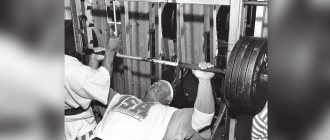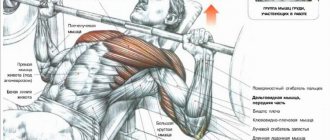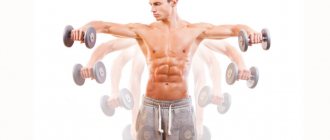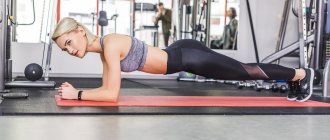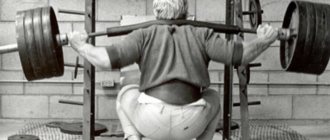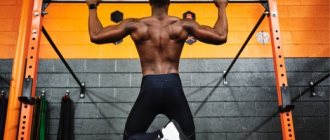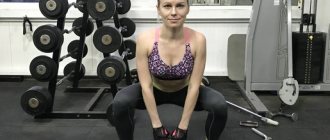© liderina — stock.adobe.com
Share:
Squats are one of the most effective exercises that tone different muscle groups, help you lose extra pounds and build muscle mass. Therefore, both beginners and sports pros include it in their training program.
Proper breathing during squats plays a huge role in the benefits and effectiveness of the element. The body spends a lot of energy to perform even one squat, so it needs a sufficient amount of oxygen. It is ensured by proper breathing.
Benefits of proper breathing
Proper breathing during squats is essential to achieve maximum effect. All aerobic and strength exercises must be accompanied by proper technique and breathing. This is the only way to improve performance and achieve health safety. Breathing technique needs to be taken more seriously when increasing the weights on squats. Inhalations and exhalations made at the right moment will help overcome the most difficult moments of the movement. As a result, you will be able to do more repetitions to optimally work the muscles.
The main thing with any training is to replenish the body with oxygen, which it spends in large quantities. Therefore, it is important not only to take deep breaths and exhales, but also to take them at the right moment. For example, exhalation should occur with maximum effort. In this case, a uniform distribution of the necessary substances into the internal organs and muscle tissue is ensured. When the lungs suddenly fill with air or are emptied in jerks, the load on the heart increases. An athlete can be overtaken by hypoxia, accompanied by loss of consciousness right during training.
Why is breathing correctly so important?
During inhalation, oxygen enters the lungs, which, together with the blood, is carried to every cell of our body, including the brain. Hypoxia or oxygen starvation during periods of intense physical activity is severe stress for the body, which can result in loss of consciousness.
Every athlete should know how to breathe correctly during squats, both without a barbell and with additional weight, at all stages of the exercise. By the way, the basis of correct breathing technique is based on the main rule - exhalation is done at maximum effort, and inhalation is done at the stage preceding it. That is, if we talk about squats, exhale while lifting, and inhale, respectively, while squatting.
You need to breathe smoothly, without jerking, try to maintain a uniform pace and depth of breaths. Otherwise, the load on the heart increases sharply, arrhythmia may develop, and blood pressure may rise. Remember this no matter what exercise you choose: Bulgarian split squats or hack exercises.
Varieties of breathing
From a physiological point of view, breathing is divided into two types:
- Chest breathing. It is common to almost all people in everyday life in a calm state without physical activity. With this breathing, the chest expands and the ribs rise.
- Abdominal breathing. Involves the participation of the diaphragm in the breathing process. It changes the volume of the chest, rising and becoming denser. This type of breathing is developed only under conditions of training and effort. It's deeper and more complete.
When doing squats, preference should be given to abdominal breathing. When a person is in a calm state, the portion of air that is obtained during chest breathing is enough for normal functioning. When squats, the diaphragm begins to work along with the lungs. It fills with air, pressing from the inside on the chest, expanding it and increasing the volume of oxygen.
If we don’t think about chest breathing, inhaling and exhaling on a subconscious level, then we should learn abdominal breathing. The technique for doing it is as follows:
- We take in air through the nose and try to direct it to the lungs and stomach area.
- We protrude the stomach slightly forward, expanding it to its maximum size.
- Slowly push carbon dioxide out through the nose or mouth, while simultaneously drawing in the abdominal muscles and tensing the abs.
When squats, exhalation and, accordingly, retraction of the abdomen should occur at the moment of lifting.
Types of breathing
Science identifies three main types of breathing:
- Abdominal or diaphragmatic. Characteristic for men. Oxygen consumption is carried out due to the work of the diaphragm, which increases intra-abdominal pressure and creates a forward displacement of the abdominal wall.
- Chest. Mainly found in women. Oxygen consumption occurs due to contraction of the intercostal muscles. Characterized by expansion and slight rise of the chest during inhalation.
- Mixed. Occurs in athletes. A combination of abdominal and thoracic types, that is, both the diaphragm muscle and the intercostal muscles are involved in the gas exchange process.
We recommend using the mixed type in strength training, as it allows you to fully nourish the body with oxygen and also prevents the occurrence of shortness of breath.
Breathing during classic squats
It is recommended to begin mastering the technique of squats and proper breathing when performing them with your own weight, that is, without a barbell or dumbbells.
The training will look like this:
- We take the starting position and free the lungs from carbon dioxide (exhale).
- We smoothly lower ourselves down, clench our lips tightly, and slowly inhale air through our nose. There is no place for haste: you still won’t be able to capture more oxygen than your lungs can accommodate.
- Inhalation must be stopped at the moment when the thighs are parallel to the floor - the time for exhalation begins. As we rise, we push carbon dioxide out of the lungs, and we can only finish exhaling at the moment of raising the body halfway, that is, we do it more intensely than when inhaling. You can exhale through your mouth.
Important point! When performing the element, the arms should not hang along the body - this prevents the chest from expanding. It is better to stretch them out in front of you or fold them in front of your chest.
It is recommended to do squats in several approaches of 10-15 times. Between approaches, a short rest is required in the form of at least five full inhalations and exhalations. You should fully restore your breathing during this rest.
Recovery breathing
Between sets of squats, you need to lower your heart rate to normal values. When you can’t measure your heartbeat using your hand, try to carry on a conversation if possible. If you talk calmly without shortness of breath, it means your heart rate has returned to normal and you can proceed to the next approach.
To speed up heart rate recovery, we recommend using a simple technique from Eastern breathing practices:
- sit on a bench, straighten your back;
- shut your mouth;
- draw air into your lungs through your nostrils, then exhale as slowly as possible (also through your nose).
Try to make the exhalation time longer than the inhalation time by 6–7 times.
Breathing while squatting with a barbell
Loaded squats allow you to pump up your hips and buttocks, as well as develop your abs and lumbar region. Therefore, after mastering regular squats, you can move on to the option with weights, for example, with a barbell or dumbbells.
© Vitaly Sova — stock.adobe.com
In this case, the training and, accordingly, breathing will be somewhat different:
- We take a deep breath and exhale sharply and approach the barbell.
- Place the barbell on your shoulders, spread your legs, and straighten your back. We remove the projectile from the racks and retreat to the specified position. If this process takes a long time, you need to inhale and exhale deeply and measuredly.
- Once again we exhale completely, inhale and begin a slow descent to the set point.
- Lifting, especially with a barbell, requires some effort, so when returning to the starting position there is no need to rush to exhale. Carbon dioxide should escape without jerking, smoothly through interlocking teeth or nostrils.
- Upon completion of the straightening, it is necessary to sharply exhale all remaining carbon dioxide and fill the lungs with oxygen again, immediately lowering down. There is no need to straighten your knees and rest.
In any case, squats with a barbell should be preceded by classic squats without weight to conduct a breathing warm-up.
Important! It is necessary to learn to control your breathing from the very first squat with a barbell. This way you will not only be able to avoid various injuries and health problems, but also develop the habit of proper breathing, which in the future will no longer need control. You will breathe correctly in all exercises automatically.
Squat technique, how to squat correctly
Squats are an excellent exercise for strengthening the muscles of the lower body, since they work several muscles at once (glutes, hamstrings, quadriceps, core stabilizer muscles). For the same reason, squats are considered one of the basic exercises. Squats also perfectly strengthen the knee, ankle and hip joints.
As a rule, if you feel how the muscles that this or that exercise is designed for work, this already indicates that the exercise is being performed correctly. If you squat incorrectly, your muscles will not only not receive the necessary load, but there is also a high chance of injury. If you feel the load on your legs, but there is no feeling that your buttocks are working, most likely, the exercise is simply not suitable for you.
So, in order to master the classic squat technique you need:
- Place your feet shoulder-width apart (let your knees point slightly to the sides).
- Place your hands along your body, hold them in front of you in a lock, or put them behind your head - you need to independently find a comfortable and safe position for your hands when performing the exercise.
- We look straight, don’t lower our heads.
A - starting position: feet shoulder-width apart, head straight, arms in front of you. B - performing a squat.
- From this starting position, while inhaling, we perform a squat until the knee joint bends at an angle of 90 degrees or slightly lower. The back remains straight, the abs tense, the gaze is directed forward as before.
- When lifting, we transfer the entire weight of the body to the heels and slowly return to the starting position as we exhale.
- At the top point, we linger for a couple of seconds, additionally straining the buttocks.
- We do the necessary 15–20 times in 2–3 approaches.
Video: Squat technique
As for the number of repetitions and recommended approaches, for beginners it is necessary to do at least 15 repetitions, then the number of repetitions can be gradually increased to 30. The main thing to remember is that it is not the number of repetitions that is more important, but the technically high-quality execution of the exercise.
- It is very important to correctly distribute the weight between the legs - when we go down, the center of gravity should be somewhere between the heels and toes.
- Under no circumstances should you slouch or round your spine while performing a squat - this can lead to injury.
- The position of the hands when performing the exercise should help maintain body balance. They should not dangle or hang.
- The squat should be deep enough (the angle at the knees is no more than 90 degrees). If the squat is not deep enough, the muscles will not receive the necessary load, and the entire approach will be done in vain.
Proper rest
It is important not only to train properly, but also to rest properly. So, there should be a short rest between sets of squats. It can last from one to six minutes, depending on the speed of recovery of your breathing and working weight. During rest, you need to breathe only through your nose . Inhalations should be as deep as possible. Exhalations should be slow until the chest is completely empty.
You need to breathe in the same rhythm and return to training only after the pulse has been completely restored and the body has been saturated with oxygen. Each new approach should begin with a deep breath to fully open the lungs. The approach should end with an exhalation.
Important! Listen to yourself. If you feel that after squats you just can’t catch your breath, then the load should be reduced. The body will not wish itself harm: it will always say that it is not ready for such a number of repetitions or such a load. Raise the bar gradually.
Breathing while resting between squats
When a person trains, special attention should be paid to breathing during rest.
Otherwise, the trainee:
- will not be able to fully recover between sets of squats;
- his heart rate will not have time to normalize;
- there will be additional stress on the lungs and vascular system;
- gets tired quickly;
- may lose consciousness during the next series of squats.
To prevent all negative consequences during rest, it is recommended:
- Inhale and exit exclusively through your nose.
- When inhaling, try to get as much oxygen as possible into the lungs.
- Exit should be done smoothly and until the chest is cleared of oxygen.
In addition, during rest it is extremely important:
- sit quietly for 1 to 6 minutes and breathe correctly through your nose;
- breathe at the same pace without faltering;
- do not hold anything in your hands and, if possible, remove your shoes.
It is most effective to relax in the fresh air or near an open window. With this option, oxygen saturation of all organs and tissues occurs twice as fast.
Experienced trainers advise not to spend more than six minutes resting between a series of squats, however, if a person feels that during this time his pulse has not leveled out, then it is permissible to extend the pause in the lesson.
In the case when a person cannot restore his breathing for more than 8–10 minutes, this indicates that the physical activity for him at the moment is unbearable. It is recommended to reduce the time or complexity of the workout.
Correct breathing technique when squats according to Bubnovsky
Squats are included in Sergei Bubnovsky’s book “50 Essential Exercises for Health.” The author also recommends combining the exercise with proper breathing techniques.
To perform squats, Bubnovsky recommends standing facing a stationary support and grasping the rubber shock absorber attached to the support. The shock absorber must be tensioned and kept at chest level. The back and arms should be straight. As you inhale, do a squat, and as you exhale, lift up. In this case, the exhalation should be accompanied by extension of the legs and the sound “ha-a”. This is the main feature of the combination of breathing and squats according to Bubnovsky. The exhalation should be sharp and the sound clear. You need to push out all the accumulated carbon dioxide with this sound.
Breathing from the diaphragm
Diaphragmatic breathing provides oxygen supply
Professional athletes breathe through their diaphragm (stomach) during squats. This allows you to increase the volume of your lungs when you inhale. The diaphragm expands the chest from the inside, the body receives more oxygen.
Beginners need time to master breathing techniques correctly. This requires regular training and a desire to learn.
- When doing abdominal breathing, when inhaling, it is necessary to direct air not only to the lungs, but also to the stomach area. In this case, the stomach should be protruded as much as possible.
- When exhaling while ascending, carbon dioxide must be released through the mouth (nostrils).
- The abs should be tensed as much as possible, and the abdominal muscles should be pulled in. If the stomach is not pulled in, the abs will begin to protrude forward, which will give the girl additional volume.
This approach allows you to provide the body with oxygen and pump up your abdominal muscles.
Professor Bubnovsky recommends supplementing diaphragmatic breathing with a long “HA” sound. This principle of cleansing the respiratory system is used in yoga. The sound allows the diaphragm to open. Otherwise, you will only be able to breathe through your chest.
A number of other features of proper breathing and additional recommendations
Why should you try to breathe only through your nose? Why don’t you need to inhale deeply and why do you need a breathing warm-up before squats? Let's move from practice to theory. Let us note a number of postulates of proper breathing:
- Inhale through the nose, exhale through the mouth. In the mucous membrane of the respiratory tract there are receptors that send a signal to the brain about the supply of oxygen, so during physical activity you need to inhale only through the nose. The mouth can only be used for exhalation. In this case, with classic squats, a quiet exhalation will be sufficient. A noisy exhalation is needed when working with heavy weights.
- We alternate inhalations and exhalations correctly. You need to inhale for the first time before starting the squat, repeated inhalations will be required each time you lower. Exhalation is done with effort, i.e. at the lowest point at the moment of the beginning of the ascent.
- We don’t breathe in for future use. Typically, the lung capacity of an adult is six liters. However, the lungs are never completely empty. During inhalation, the maximum allowable amount of air that can be stored is two liters. Therefore, taking an excessively deep breath at the beginning of the exercise can lead to rapid and shallow breathing. And this can lead to uneven distribution of oxygen throughout the tissues, which can cause loss of consciousness.
- Breathing warm-up is the key to successful training. In order for the body to adapt to a kind of breathing during physical activity, it is necessary to prepare the respiratory system. The lungs must be properly ventilated and blood circulation improved. To do this, you need breathing exercises at the beginning of any training.
And finally, a mini instruction sign for all occasions:
| Squatting situation | What should breathing be like? |
| Fast squats | Shallow and frequent |
| Smooth training | Measured, unhurried |
| The purpose of squats is to pump up your legs | You need to empty your lungs as much as possible when lifting. |
And one more thing: beginners need to monitor their breathing, but not focus entirely on it. Choose an acceptable breathing rate for yourself and gradually get used to it.
How to breathe correctly when squatting with a barbell?
The barbell squat is a fairly heavy exercise, made even more difficult by free weights. Proper breathing technique is important in any case, but the more weight used, the greater its importance. In the question of how to breathe during squats with a barbell, you need to understand the following:
- First, it is recommended to do a few light bodyweight squats to warm up. This will help activate breathing and set the body to the correct technique.
- You need to take the starting position, placing the barbell on your shoulders, straighten your back and legs. Take a deep natural breath .
- While there is air in your lungs, lower yourself by pushing your pelvis back and bending your knees. The torso should be slightly tilted forward, but not rounding the back, maintaining a deflection in the lower back . While in this phase, approximately in the middle of the squat, you can hold your breath a little, but only for a split second.
- When you reach the lowest point, where the correct body position can still be maintained, there is no need to rush to exhale. Begin to rise to the starting position.
- The most energy-consuming stage of the exercise is the upward movement, so it should be accompanied by exhalation. But do not exhale immediately, but somewhere in the middle of the rise. You can exhale sharply, facilitating the upward movement of the barbell.
- The exhalation ends when you return to the top point and a new breath is taken. One squat is done in this way.
In the question of how to breathe correctly during squats, controlling your breathing in your thoughts and dividing the exercise into stages helps. This will help you stay in rhythm at first, and then you will get used to breathing this way. The pace of breathing corresponds to the position of the body. By straightening it, we fill our lungs with air, and when the muscles contract and we make efforts, we automatically want to exhale.
Breathing according to prescription
Sometimes even a simple five-minute deepening of breathing can miraculously charge us with energy, and simply replenish the lack of optimism. But you can achieve an even greater effect with the regular practice of pranayama - a system of special breathing exercises. These techniques, tirelessly refined by yogis over the past few millennia, purposefully change the speed, rhythm and volume of breathing.
One warning before starting the practice: when performing any of the breathing exercises, you should never overdo it. If you feel uncomfortable, return to your normal breathing rhythm. If the discomfort intensifies, this is a signal to stop the exercises. Your breath, believe it or not, has a natural intelligence, honed over millions of years of evolution. Learn to recognize these signals and respond to them.
Usually pranayama is performed while sitting on the floor, with the spine straight and elongated - for example, in Padmasana or Siddhasana. But such poses are absolutely not suitable for beginners: after just a few minutes they begin to suffer from pain and lose all ability to concentrate. Therefore, if you have started doing yoga relatively recently, it is better to sit on a chair or lie on the floor on your back. If the floor is hard, place a folded blanket under your torso and a small, hard pillow under your head. Stretch your legs straight, spreading your heels ten centimeters apart. Or you can bend your knees slightly and place a bolster or another folded blanket underneath. This pose will help relax your tense back and stomach. Stretch your arms to the sides. Place a silk bag over your eyes for relaxation.
We recommend reading: How often to pump up your abs
Finding yourself in a comfortable position, observe your normal breathing for a few minutes, recording the results in your mind. Then, for a minute, mentally count the duration of your inhalations and exhalations - for example, “one second,” “two seconds,” etc. (or, if you prefer, “one Omm,” “two Omm”). Don't be surprised if your exhalations are a little longer than your inhalations; this is quite normal. When you focus on your breathing, you can move on to exercises that heal anxiety, fatigue and depression.
Anxiety. You can deal with it by lengthening your exhalations. For example, if your normal exhalation lasts six seconds, try to stretch out several exhalations to seven seconds, then several exhalations to eight, and so on until you reach your limit - the longest but still comfortable exhalation.
When you increase the duration of your exhalations by a few seconds in this way, pay attention to their subtle sound. You will notice that with each exhalation you get a soft ha - like a light sigh. Try to make this sound as soft and even as possible - from the beginning to the end of the exhalation. Pause briefly at the end of each exhalation, lying quietly and still. Continuing in this manner, observe your breathing for at least 10–15 minutes.
Fatigue. To overcome fatigue, you need, on the contrary, to lengthen your breaths. Breathe as usual for a few minutes. When your breathing becomes even and slow, take a short pause after exhaling. Freeze. After a few seconds, you will feel something like vibrations - the approach of the next breath. The sensation is reminiscent of a wave rushing towards the shore. Don't inhale immediately. Instead, let the “wave” get even higher. Then inhale without effort or resistance.
Increase the length of time you hold your breath before inhaling. Then gradually lengthen your inhalations, just as you did with your exhalations in the previous exercise. Finally, pay attention to the sound of your breaths - a slightly hissing sound, yogis call it sa. Try to make the sound as soft and even as possible - from the beginning to the end of the inhalation. Observe your breathing for 10–15 minutes.
Depression. Getting rid of depression is much more difficult. Don't exercise when you're at your worst. Forcibly changing your breathing rhythm can only worsen the situation.
Allow your breathing to slow down and become more even. Then count the duration of your inhalation. When you exhale, try to balance its duration with your inhalation. Inhale and exhale evenly for about a minute. Then gradually—once every three to four breaths—increase each inhalation and exhalation by a second until you reach your maximum. The best timer will be your mood. For example, if you decide to practice for ten minutes, be prepared to shorten that time if you feel the depression subsiding. But if you find that you still need exercise, don't stop.
Recharging. Build into your schedule a daily 10-minute breathing exercise at your calmest time of day. For some it is early morning, for others they manage to truly relax only in the evening. However, even if you cannot regularly exercise at the same time, it is enough to take a simple minute break several times a day - close your eyes and do the exercise. It may turn out that such breaks will invigorate you much better than the usual cup of coffee or chocolate.
It is very important to breathe properly when doing push-ups, as improper breathing can lead to heart problems.
A healthy lifestyle is becoming very popular nowadays. Morning exercises are one of its foundations. Of course, it consists of simple exercises, but given the modern sedentary lifestyle, even these can benefit the body.
We recommend reading: Abdominal superset
Although there are some pitfalls here too. All exercises, even the simplest ones, must be performed correctly and it is very important, first of all, to breathe correctly. Otherwise, charging will bring not only benefits, but also harm.
Push-ups from the floor or bench are one of the simplest exercises. How to breathe correctly when doing push-ups? Unfortunately, few people think about this issue, but in vain. Improper breathing during bodybuilding or athletic activities can lead to problems with the cardiovascular system.
During push-ups, you need to breathe like this: while moving down, inhale air with your stomach, while your stomach should inflate, when going up, exhale slowly. That is, exhalation occurs at the moment of effort. This rule is usually followed when performing other exercises.
Holding your breath is a very common mistake that can lead to a lot of undesirable consequences. Often beginners, and not only others, completely stop breathing while doing exercises. Yes, it seems easier to lift heavy weights this way, but lack of oxygen can lead to weakness and loss of consciousness in some cases. The pressure also increases greatly, which can lead to microruptures in the blood vessels of the brain.
All this happens because when you inhale, the load on the cardiovascular system increases, and to all this the load from performing the exercise is added. As you exhale, the load on the cardiovascular system decreases, that is, a kind of compensation occurs.
When doing push-ups, you need to make sure that your back is as straight as possible, avoid arching in the lower back and try, if possible, not to strain muscles that are not involved in the exercise (as in the picture).
To achieve the greatest effect from this exercise, you need to perform several approaches. For example, three sets of 10 repetitions each. You should take a short break between sets to allow the muscles to recover. By doing push-ups like this, you can do more repetitions and load your muscles better.
Calculate your ideal sports weight!
Again, it is advisable to constantly increase the load. That is, the number of repetitions can be increased day by day.
What are the benefits of proper breathing?
All exercise, be it strength or aerobic, must be performed correctly. And this includes not only the technique of execution, but also the ability to breathe correctly. Breathing while squatting will allow you to get maximum results from the exercise. In addition, it has a positive effect on health.
Improper breathing during exercise can be harmful. For example, if you hold your breath during a basic exercise, this will lead to an increase in pressure. As a result, headache and inability to continue training.
Thus, it is better to know how to breathe properly when squatting and take it as seriously as possible. This will be especially true when working with large weights:
- Correctly done inhalations and exhalations will make it easier to overcome various difficult moments.
- This will not only be safe for health, but will also make it possible to make your workout more productive by increasing the number of approaches and repetitions.
When working with heavy weights, you need to not only inhale and exhale, but do it at the right moment. For example, maximum effort occurs during exhalation. At this moment, oxygen disperses throughout the body, entering muscle tissue, the brain, carrying the necessary substances and hormones to the organs.
Do you want to improve your figure and health, without harming your spine and joints? Get my free resources on smart fitness at the gym or at home and learn how to exercise the right way!
They are suitable for both beginners and advanced fitness fans.
